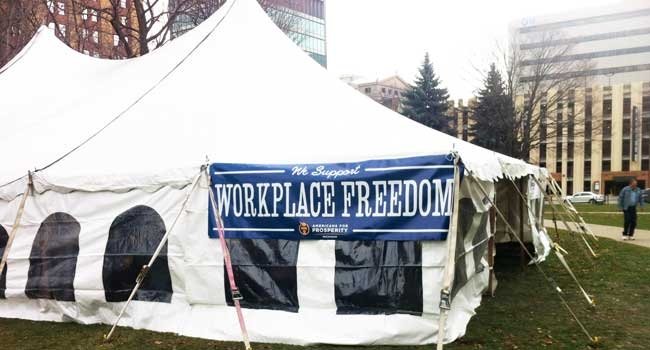Ben Stewart presents an on-the-ground look at anti-union events in Michigan
Almost three thousand union members and supporters streamed into the Michigan state capital in Lansing on Thursday, December 6. Many arrived via the Walter Reuther Expressway from Detroit. Protestors donned hard hats, scrubs and overalls, chanting “Hey Hey! Ho Ho! Right to Work Has Got to Go!” As police lines held back the crowds of union members, and locked them out of the governors’ office building and the Capitol, the reality began to sink in. Michigan was going to be a “right to work” state.
No more than fifty Tea Party activists were visible on Thursday. Some took this as a sign of weak public support for the law. “Do you all see that big tent in front of the Capitol,” said a leader of one union, referring to a staging location used by Americans for Prosperity. “The Tea Party is over there. There’s about 5 people in there, so that’s how many people in Michigan want to see Right to Work.”
Nevertheless, Tea Party groups were crucial to pushing right to work on the agenda in a state where such legislation was unthinkable only a few years ago. As IREHR reported in September of last year, Tea Partiers have been steadily holding meetings, lobbying state legislators and training spokespeople in the fight for what they termed “freedom to work.”
After unions lost a series of ballot initiatives this November, Michigan Tea Party groups saw an opening to pass right to work. On November 12th, Tea Party leader Jack Hoogendyk emailed supporters to begin pressuring state senate leader Randy Richardville (R) to support the legislation. “It is time for Michigan to become a right-to-work state,” wrote Hoogendyk. “If ever the conditions were perfect for this to happen, they are right now.”[1]. Richardville and some other Republicans had previously been hesitant to engage the issue, fearing blowback from labor.
Apparently they got the message. On November 15th Hoogendyk sent another email to supporters, this time informing them that Richardville had pledged to support a vote of his caucus on right to work.[2] The chips were falling into place. Over the next two weeks, Tea Party groups organized lobby days to influence the lame duck session of the state legislature on issues ranging from abortion to health reform and, of course, right to work.
On December 4th, Americans for Prosperity sponsored a “Workplace Freedom” lobby day. An ad promoting right to work appeared the same day on TV screens across Michigan. It was sponsored by the Michigan Freedom Fund, which is controlled by Amway founder and Michigan native Dick Devos.[3] On the morning of Thursday the 6th, Governor Snyder hosted a press conference announcing plans for right to work legislation.[4] Sitting beside him was Terry Bowman, a member of the Rattle With Us Tea Party. IREHR readers may recall Bowman as the spokesperson for Union Conservatives, a group purporting to represent union members in support of right to work.[5]
By Thursday afternoon, in the face of throngs of incensed protestors, the state senate had introduced and passed two separate right to work bills, one covering the private sector and another for the public sector. The final legislation is expected to pass through the state house on Tuesday and be signed by the governor shortly thereafter.
Although business groups have come out in support of right to work, most notably the Michigan Chamber of Commerce, they did not do so until well after the Tea Parties lit the fire.[6] Auto industry giants Ford, Chrysler and General Motors still maintain an officially neutral policy on right to work.[7]
Right to work legislation may prove to be the crown jewel atop a mass of union busting laws passed in Michigan since 2010. According to research conducted by the Midwest Center for Equality and Democracy for a forthcoming report on anti-union legislation in the states, in 2012 alone 41 bills curtailing union rights have been proposed in the Michigan legislature. 16 of those bills have been enacted.[8]
What will right to work mean for Michigan and America?
Michigan workers were at the center of the CIO movement which birthed industrial unionism during the Depression-era 1930s. The Flint sit-down strike of 1937, which resulted in a United Auto Workers contract for workers at General Motors, is widely regarded today as the climactic battle of the era. And union assembly line workers played an all-important role in the war against Nazism, in places like the massive Willow Run Aircraft Factory in Ypsilanti, Michigan.
Right to work deals a body blow to the Michigan labor movement that will reverberate around the nation. According to the most recent Bureau of Labor Statistics data, there are 670,935 union members in Michigan, or 17.5 percent of the total workforce. The union membership percentage, or density rate, in right to work states averages just 6.5 percent. By this standard, Michigan faces the very real possibility of losing hundreds of thousands of union members over the coming years.
Nationally, union membership is at 11.8 percent, down from a peak of 34 percent in 1945. Such a severe loss in Michigan today would be one more setback for American working people, whose standard of living has fallen in step with the decline of trade unions.[9]
Currently 23 states have adopted right to work legislation. In those states, as many labor leaders have pointed out, income inequality is higher, wages are lower, and the general welfare of all but the wealthiest few is significantly worse than in states without right to work laws. The Tea Party’s drive to pass right to work is about more than just crippling the power of organized labor. It is an attack on working families everywhere.
The AFL-CIO has called for thousands to assemble in Lansing on Tuesday, December 11th. Although it is unlikely that anything will be able to stop the passage of right to work legislation for now, do not expect the battle to end on Tuesday.
We can be sure that the Tea Party will not stop fighting.
[5]. http://tremololabs.comissue-areas/tea-party-nationalism/tea-party-news-and-analysis/item/371-michigan-tea-party-supports-right-to-work





